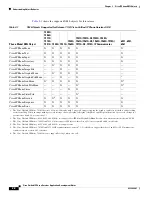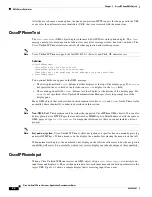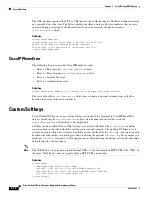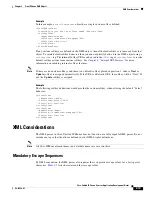
2-6
Cisco Unified IP Phone Services Application Development Notes
OL-18696-01
Chapter 2 CiscoIPPhone XML Objects
XML Object Definitions
During text entry, Cisco Unified IP Phones display softkeys to assist users with text entry. Users can
navigate between fields with the vertical scroll button that is used to navigate menus, and so on.
CiscoIPPhoneDirectory
The phone originally incorporated the
CiscoIPPhoneDirectory
XML object to support the Directory
operation of Cisco Unified IP Phones, but it is available for your development purposes also.
Figure 2-2
shows how an XML
CiscoIPPhoneDirectory
object displays on the phone.
Figure 2-2
CiscoIPPhoneDirectory Object Display Sample
Definition
<CiscoIPPhoneDirectory>
<Title>Directory title goes here</Title>
<Prompt>Prompt text goes here</Prompt>
<DirectoryEntry>
<Name>The name of the directory entry</Name>
<Telephone>The telephone number for the entry</Telephone>
</DirectoryEntry>
</CiscoIPPhoneDirectory>
Note
For the directory listing, the Cisco Unified IP Phone displays the appropriate softkeys that are needed to
dial the numbers that are listed on the display. The softkeys include the Edit Dial softkey, which allows
users to insert access codes or other necessary items before dialing.
L
Lowercase—enter lowercase letters as the only acceptable input.
P
Password field—enter individual characters using the standard
keypad-repeat entry mode. The system automatically converts
accepted characters into an asterisk, keeping the entered value
private.
Note
P specifies the only
InputFlag
that works as a modifier. For
example, specify a value of “AP” in the
InputFlag
field to
use plain ASCII as the input type and to mask the input as a
password by using an asterisk (*).
InputFlag
Description
















































